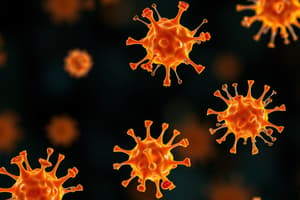Podcast
Questions and Answers
Which of the following outcomes is LEAST likely to occur when immature lymphocytes encounter self-antigen?
Which of the following outcomes is LEAST likely to occur when immature lymphocytes encounter self-antigen?
- Elimination of autoreactive cells through programmed cell death.
- Receptor editing to alter antigen specificity.
- Differentiation into T regulatory cells to suppress autoimmunity.
- Activation of inflammatory cytokine production. (correct)
A researcher identifies a population of lymphocytes in the thymus undergoing receptor editing. What is the MOST probable reason for this observation?
A researcher identifies a population of lymphocytes in the thymus undergoing receptor editing. What is the MOST probable reason for this observation?
- The lymphocytes have encountered self-antigens and are modifying their receptors to avoid autoimmunity. (correct)
- The lymphocytes are undergoing normal clonal expansion during an immune response.
- The lymphocytes are responding to a novel viral infection.
- The lymphocytes are differentiating into natural killer cells.
A patient has a mutation that impairs the function of apoptosis pathways in lymphocytes. Which of the following immunological consequences is MOST likely to arise from this mutation?
A patient has a mutation that impairs the function of apoptosis pathways in lymphocytes. Which of the following immunological consequences is MOST likely to arise from this mutation?
- Development of autoimmune disorders. (correct)
- Increased susceptibility to intracellular bacterial infections.
- Enhanced clearance of viral infections.
- Impaired antibody production following vaccination.
Which outcome is MOST beneficial to the host?
Which outcome is MOST beneficial to the host?
In a study, it's observed that a significant number of autoreactive lymphocytes are detected in the peripheral blood of an individual. Which of the following outcomes during lymphocyte development MOST likely failed to occur effectively in this individual?
In a study, it's observed that a significant number of autoreactive lymphocytes are detected in the peripheral blood of an individual. Which of the following outcomes during lymphocyte development MOST likely failed to occur effectively in this individual?
Molecular mimicry, where antigens on microbes resemble host molecules, can lead to what immunological outcome?
Molecular mimicry, where antigens on microbes resemble host molecules, can lead to what immunological outcome?
In the context of molecular mimicry, how does the similarity between microbial and host antigens affect immune responses?
In the context of molecular mimicry, how does the similarity between microbial and host antigens affect immune responses?
Which of the following scenarios exemplifies the potential consequences of antigenic cross-reactivity in molecular mimicry?
Which of the following scenarios exemplifies the potential consequences of antigenic cross-reactivity in molecular mimicry?
What is the most direct mechanism by which molecular mimicry can lead to autoimmune disease?
What is the most direct mechanism by which molecular mimicry can lead to autoimmune disease?
If a certain bacterial infection is known to trigger molecular mimicry, what would be the most concerning long-term health risk for an individual who contracts the infection?
If a certain bacterial infection is known to trigger molecular mimicry, what would be the most concerning long-term health risk for an individual who contracts the infection?
Flashcards
T Regulatory Cell Conversion
T Regulatory Cell Conversion
Immature lymphocytes binding to self-antigen can result in the cell becoming a T regulatory cell.
B-cell Receptor Editing
B-cell Receptor Editing
Some B-cells change their receptors to avoid self-antigen binding.
Autoreactive Cell Deletion
Autoreactive Cell Deletion
Self-reactive lymphocytes are removed via programmed cell death.
Escape to the Periphery
Escape to the Periphery
Signup and view all the flashcards
Apoptosis of Autoreactive Cells
Apoptosis of Autoreactive Cells
Signup and view all the flashcards
Antigenic Cross-Reactivity
Antigenic Cross-Reactivity
Signup and view all the flashcards
Molecular Mimicry
Molecular Mimicry
Signup and view all the flashcards
Host Self-Molecules
Host Self-Molecules
Signup and view all the flashcards
Autoimmune Response
Autoimmune Response
Signup and view all the flashcards
Antigen Similarity
Antigen Similarity
Signup and view all the flashcards
Study Notes
- Autoimmunity occurs when the immune system attacks self tissues due to a breakdown in tolerance.
- Immunologic tolerance is the state of unresponsiveness to self-antigens.
Mechanisms of Immunologic Tolerance
- Central tolerance
- Peripheral tolerance
Central Tolerance
- Negative clonal selection eliminates T and B lymphocytes in the thymus and bone marrow that react to self-antigens.
- If immature lymphocytes bind to self-antigen, the four possible outcomes are:
- Becoming a T regulatory cell CD4+CD25+
- B-cells receptor editing (change to a different one).
- Deletion of autoreactive cells by apoptosis.
- Escape to the periphery.
Peripheral Tolerance
- This type of tolerance is induced when mature cells recognize self-antigens in peripheral tissues.
- This leads to:
- Deletion of autoreactive cells by apoptosis.
- Anergy: inactivation (alive but nonfunctioning).
- Suppression by T regulatory cells, which secrete inhibitory cytokines (IL-10 & TGF-β).
Factors Predisposing to Autoimmune Diseases
- Genetic Factors: HLA genes in particular.
- Hormonal Factors: Autoimmune diseases are more common in women than men.
- Environmental factors: Infections, diet, sun exposure, and stress all factor in.
- Tissue destruction results from hypersensitivity reactions types 2, 3, and 4.
Mechanisms of Loss of Self-Tolerance
- Various situations can cause self-reactive immune cells to overcome self-tolerance.
- Antigenic cross-reactivity (molecular mimicry): Antigens on some microorganisms are similar to host self-molecules, so immune responses attack the host cells.
- Streptococcus pyogenes: Causes Rheumatic fever
- Coxsackievirus & CMV: Type-1 DM
- EBV: Multiple sclerosis.
- Epitope spreading: Viral infections lead to tissue destruction, exposing self epitopes to the immune system, and resulting in destruction of self-antigens.
- Coxsackievirus infection of the thyroid gland; can cause Hashimoto's thyroiditis.
- Neoantigens formation: Self-antigens are modified by extrinsic factors.
- Penicillin and a-methyl-dopa drugs can induce autoimmune hemolytic anemia.
- Haemolytic anaemia disappears when the drug is discontinued
- Dysfunction/decreased numbers of T regulatory cells: This can be caused by genetic factors or aging, leading to loss of suppression.
- Diabetes type-1
- Hashimoto's thyroiditis.
- Systemic lupus erythematosus.
- Release of sequestered antigens: Self-molecules are normally "sequestered" and not exposed to the immune system.
- Trauma or surgery can release these antigens, stimulating an immune response and causing autoimmune disease.
- Anti-sperms antibodies: Male Sterility.
- Anti-IgG antibodies (rheumatoid factor): Rheumatoid arthritis.
- Trauma or surgery can release these antigens, stimulating an immune response and causing autoimmune disease.
- Polyclonal B lymphocyte activation: Epstein-Barr virus infection (Infectious mononucleosis) can produce heterophile that act as self-reactive antibodies.
- Systemic lupus erythematosus exhibits these.
Classification & Diagnosis
- Organ Specific Autoimmune Diseases:
- Pernicious anemia: Anti-intrinsic factor antibodies.
- Multiple sclerosis: Cell mediated destruction of the myelin protein.
- Myasthenia gravis: Anti-acetylcholine receptor antibodies
- Hashimoto thyroiditis: anti-thyroglobulin antibodies
- Systemic Autoimmune Disease:
- Rheumatoid arthritis: Anti-IgG antibodies (rheumatoid factor)
- Systemic lupus erythematosus (SLE): Antinuclear antibodies (ANA): Anti-dsDNA antibodies
Treatment of Autoimmune Diseases
- Replacement Therapy:
- Insulin for Type-1 diabetes
- Thyroxin for Hashimoto thyroiditis
- Vitamin B12 in pernicious anemia
- Anti-inflammatory & Immunosuppressive Drugs
- Immunomodulators (Biologics):
- Anti-TNFα: Rheumatoid arthritis
- Anti-IL-2 Receptor: Multiple sclerosis.
- Anti-CD20: Rheumatoid arthritis, autoimmune hemolytic anemia.
Studying That Suits You
Use AI to generate personalized quizzes and flashcards to suit your learning preferences.
Related Documents
Description
This lesson covers autoimmunity, which occurs when the immune system attacks self tissues due to a breakdown in tolerance. It discusses the mechanisms of immunologic tolerance, including central and peripheral tolerance. Central tolerance involves negative clonal selection, while peripheral tolerance occurs when mature cells recognize self-antigens in peripheral tissues.



